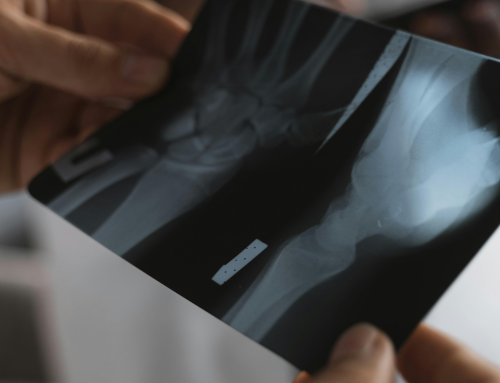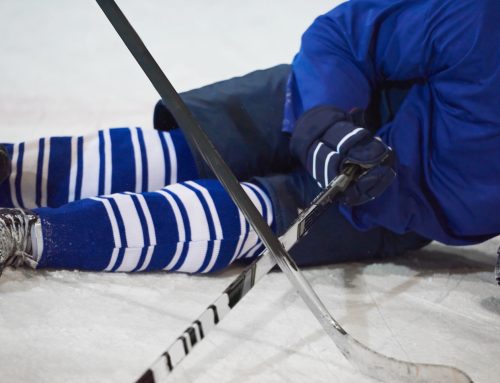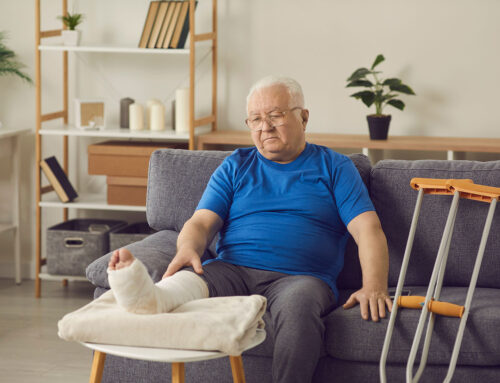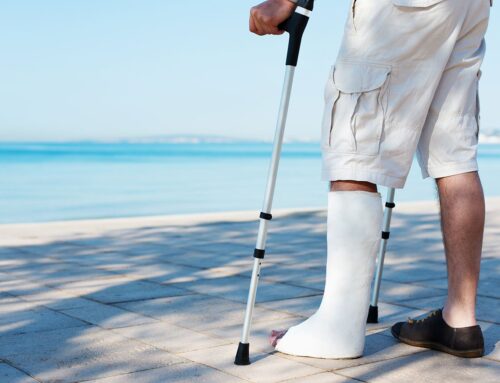When winter arrives, it brings with it a certain type of quiet beauty. The air gets crisp, the first snowflakes begin to float down, and everything feels just a little bit cozier.
But as the temperatures drop, there’s a new danger lurking on our sidewalks, driveways, and parking lots: ice.
For many older adults, a simple walk to the mailbox can turn into a life-altering event. It only takes a second for a devastating slip and fall injury, but it can lead to a fracture that threatens your independence.

One moment, you’re steady, and the next, you’re on the ground, dealing with intense pain and worries about how your life is about to change. A fracture can shake your confidence and leave you feeling vulnerable, and the thought of a long, slow recovery can be a daunting one. That’s especially true if you’re used to an active, independent lifestyle.
So, what helps fractured bones heal faster, and is there any way to speed up the process?
If you’re dealing with the aftermath of a slip and fall, or a caregiver helping a loved one, this post is for you. We’ll explain why slips and falls spike in the winter months, which bones are most at risk, and how you can get those fractured bones healed faster so you can get back to your daily routine.
Quick Takeaways
- Ice and snow significantly increase the likelihood of falls, especially for older adults.
- Aging reduces balance, muscle strength, and reaction times, making it harder to recover from stumbles.
- Wrist, hip, ankle, and spinal compression fractures are the most frequent injuries caused by falls on ice.
- Low-Intensity Pulsed Ultrasound (LIPUS) is a non-invasive, pain-free therapy clinically proven to speed up bone healing by up to 38%.
- LIPUS is effective for both fresh fractures and stubborn nonunions and offers a faster path to recovery.
Why Winter Increases the Risk of a Slip and Fall
Hospitals tend to see a significant spike in fractures as soon as that first frost hits. In Canada, falls account for 80% of seniors’ injury-related hospitalizations and 90% of all hip fractures. When you add a layer of slick ice into the mix, the risk of problems skyrockets.
Why does this happen? It’s all due to a combination of factors:
Our Bodies Change As We Age
When we get older, our bodies naturally go through changes that can make us more susceptible to a slip and fall injury. Our sense of balance diminishes, our muscles might not be as strong as they once were, and our reaction times can slow down.
While a younger person might easily catch themselves during a stumble, for someone over 60, that same stumble can easily lead to a hard fall.
Eyesight also plays a role, as it becomes harder to spot patches of black ice, particularly in low light during our short winter days. What looks just like wet pavement could instead be a treacherous sheet of ice waiting to break or fracture our bones.
The Physics of a Fall
When you fall on a hard, unyielding surface like ice, instead of landing on something like dirt, your body naturally absorbs the full impact. Your instinct is to put your hands out to break the fall, a protective reflex that explains why wrist fractures are so incredibly common.
Rather than your head or torso hitting the ground, your small wrist bones take the force. Often, they can’t withstand the hit.
If you fall backward or to the side, your hip is likely to take the brunt of the impact. The hip joint happens to be one of the largest and strongest in the body, but a direct blow can easily fracture it.
This kind of injury can be particularly devastating for older adults, often requiring surgery and extensive rehabilitation.
The Most Common Winter Fractures
While any bone can break, falls on ice are more likely to cause a few specific types of fractures. These include:
- Distal Radius (Wrist) Fracture: This is the classic injury from falling on an outstretched hand. You’ll experience immediate pain, swelling, and difficulty moving your wrist. It’s one of the most frequent injuries seen in emergency rooms, and especially so after the first snowfall.
- Hip Fracture: A hip fracture is a break in the upper part of your femur (thigh bone). This is a severe slip and fall injury that almost always requires surgical intervention. Recovery is a long road, and regaining mobility is a major concern for patients and their families.
- Ankle Fracture: Twisting your foot as you fall can lead to one or more broken bones in your ankle. Depending on the severity, you might need a cast or surgery. An ankle fracture makes it impossible to put weight on your foot, severely limiting your mobility.
- Spinal Compression Fracture: Falling flat on your back or buttocks can sometimes cause one of the vertebrae in your spine to collapse. This type of slip and fall injury can lead to chronic back pain and a stooped posture if it’s not managed correctly.
The standard advice for many of these fractures is rest. Likely, you’ll be told to stay off your feet, keep the limb elevated, and let nature take its course. But while rest is key, waiting isn’t the only thing you can or should do. Now, there’s technology available that can actively help your bones heal much faster.
What Helps Fractured Bones Heal Faster? Meet LIPUS
Wouldn’t it be great if you could give your body’s natural healing process a helping hand? If you could actively encourage your bone cells to repair themselves more efficiently? Believe it or not, you actually can.
LIPUS, or Low-Intensity Pulsed Ultrasound, is designed for this specific purpose. It’s a non-invasive, pain-free therapy you can use at home—a small, portable device that you place directly on the skin over your fracture site for just 20 minutes a day. The device sends low-intensity, high-frequency sound waves deep into the tissue.
You won’t feel a thing, but on a cellular level, there are some remarkable changes taking place. These ultrasonic pulses create tiny mechanical pressures on your bone cells, with the simulation acting as a wake-up call for your body’s repair crew. It signals the cells to get to work, accelerating the three key stages of bone healing:
- Inflammation: It helps manage the initial swelling and brings more of the essential cells needed for repair to the fracture site.
- Soft Callus Formation: It speeds up the creation of the soft cartilage “scaffolding” that bridges the gap in the broken bone.
- Hard Callus Formation: It encourages the transformation of that soft callus into hard, solid bone, making the fracture more stable.
Basically, you’re telling the bone to get to work! The LIPUS treatment doesn't force anything. Instead, it simply supports and improves the natural processes your body already knows how to do.
The Evidence Behind LIPUS Treatment
LIPUS likely sounds too good to be true, but it’s backed by science. The technology has been studied for decades and is clinically proven to speed up bone healing.
For fresh fractures, studies have shown that LIPUS treatment can reduce healing time by up to 38%. That could mean getting out of a cast weeks earlier, starting physiotherapy sooner, and returning to your daily activities more quickly.
If you’re someone recovering from a slip and fall injury, that difference is far from minor. It’s the difference between relying on your family for groceries and being able to drive to the store to get them yourself.
LIPUS is also incredibly effective for fractures that are struggling to heal, known as “nonunions” or “delayed unions.” These happen when the bone’s natural healing process, for whatever reason, stalls. A nonunion can be a frustrating complication of a slip and fall injury, sometimes requiring yet another surgery. LIPUS treatment has a proven success rate of 87% in healing these stubborn fractures and offers another safe, effective alternative to surgical intervention.
Taking Control of Your Recovery After a Slip and Fall Injury
A fracture from a slip and fall injury can make you feel powerless, but using a LIPUS device puts control back in your hands. Rather than passively waiting for healing to happen, you’re taking an active step every single day to support your body’s recovery. While we’ve acknowledged the many physical benefits in this post, it’s also important to recognize the psychological win: this kind of agency can boost your morale during a difficult time.
Getting started with LIPUS is straightforward. Once you have a diagnosed fracture, you can begin therapy at home. The Melmak LIPUS device works right alongside standard treatments like casts, splints, or even surgical plates and screws. Simply place the device over the fracture site for your daily 20-minute session. It’s that easy.
Winter will always bring the risk of ice, but a fracture doesn’t have to mean months of lost independence. You have options that go beyond just waiting.





